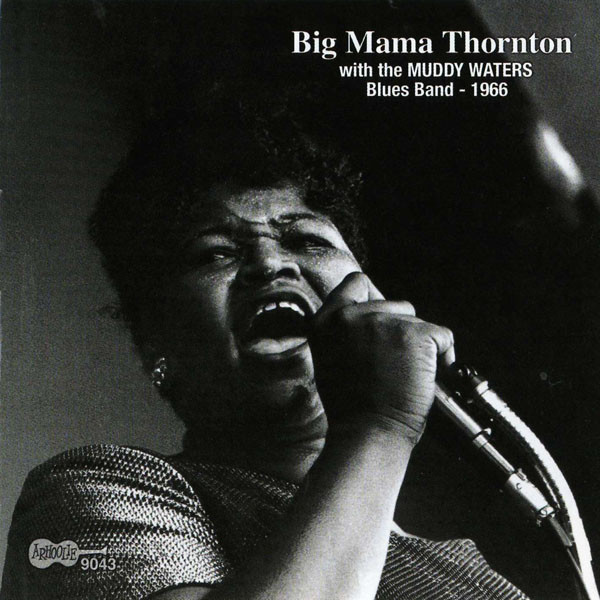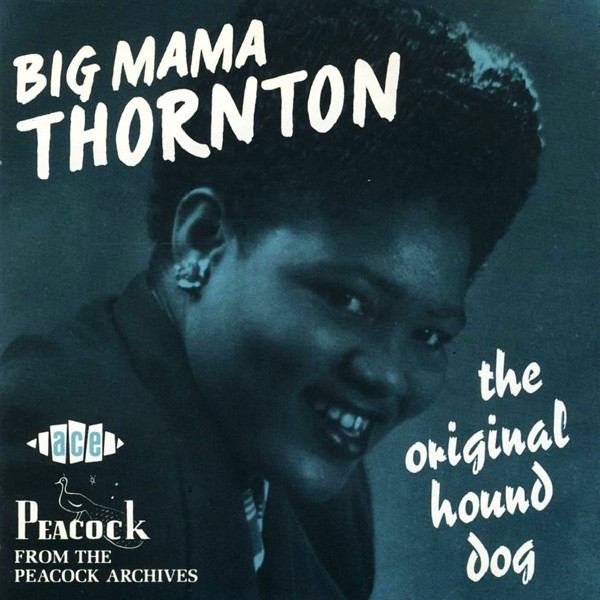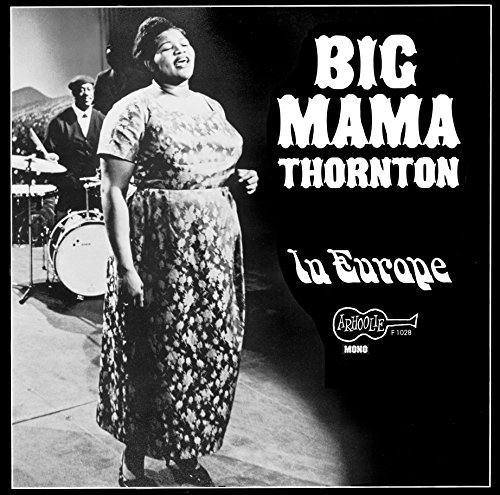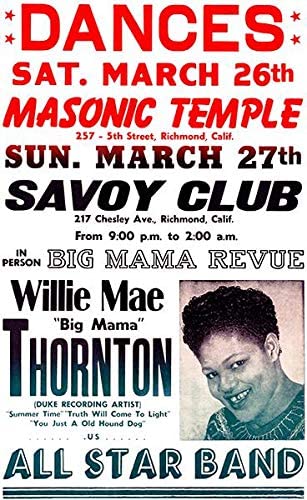
BIG MAMA THORNTON December 11, 1926 – July 25, 1984
RECOMMENDED ALBUMS: BIG MAMA THORNTON IN EURPOE (Arhoolie), BIG MAMA THORNTON AND THE MUDDY WATERS BLUES BAND (Arhoolie), THE ORIGINAL HOUND DOG (Ace Records)
While there are many who claim to be the true “Queen of the Blues” few make a better argument then Willie Mae “Big Mama” Thornton. Born near Montgomery, Alabama in 1926 Big Mama enjoyed an incredible career that lasted over 30 years. Even though she never became as much of a household name as the people she influenced she still made her mark on the music world. While she is best known for singing the original version of the song “Hound Dog” (a song that was written specifically for her) that is only the tip of the iceberg when it comes to her influence on music history. An openly gay African-American woman in the music industry Big Mama was a trailblazer. She commanded the stage with her towering figure and booming voice. Artists such as Aretha Franklin and Janis Joplin sang her praises (quite literally in the case of Janis) and there is even a music camp for young women named in her honor (williemaerockcamp.org). While life wasn’t always easy for Big Mama she always stuck to her guns and kept moving forward.

BIG MAMA’S HOUND DOG
Recorded 1952 and released on Don Robey’s Peacock Records, Big Mama’s version of “Hound Dog” was an instant hit. Originally more of a blues song, “Hound Dog” was written with Big Mama specifically in mind by the songwriting team of Jerry Leiber and Mike Stoller. Even though the song eventually became a number 1 hit, it didn’t translate into a big payday for anyone except record label owner Don Robey. While the exact story isn’t totally clear, Big Mama only received $500 for her services and songwriters Jerry Leiber and Mike Stoller got almost nothing. Of course Leiber and Stroller would eventually cash in BIG in 1956 when Elvis Presley recorded his reworked version of “Hound Dog” but as Big Mama wasn’t one of the songwriters the success of the Elvis version didn’t translate into any kind of payday for her. Always the business man, Robey tried to cash in again for himself when the Elvis version became a hit by rereleasing Big Mama’s version of the track but nothing much came of it. In 1965 Big Mama re-recorded the tune with blues guitar great Buddy Guy for her album BIG MAMA THORNTON IN EUROPE. This version might be some of her best work and smokes any version ever sung by Elvis.
THE SIXTIES
While she made many recordings during her career it was her live performances that set her apart from other blues singers. An entertainer through and though, Big Mama was a multi-instrumentalist and her live show regularly featured her playing a variety of instruments. She kept a rigorous touring schedule usually touring as part of travelling multi-performer blues revues and package tours with other artists. Even though she was almost always the only woman on these shows Big Mama NEVER got pushed around and usually was the highlight of the show. In fact there were several times when performing as the opening act, she put on such a powerful show that the headliner refused to perform! That said, the life of a touring musician can be a grueling and strenuous one. In the late 50’s. Rock n’ Roll and Soul started taking over the music charts and soon barroom blues artists like Big Mama were left on the outside looking in. Realizing it was time for a change she relocated to the San Francisco Bay Area and began performing in local clubs.
 As the sixties began Big Mama started to see her career pick up steam again. In 1965 she recorded her first album for the Berkeley based roots music label Arhoolie. Entitled BIG MAMA THORNTON IN EUROPE, and recorded while she was on tour in Europe with traditional Chicago blues legends Buddy Guy, Big Walter Horton, and Eddie Boyd this album turned out to be one of the best albums of her career. While Big Mama sounds right at home fronting a big electric band, producer (and Arhoolie label owner) Chris Strachwitz fortunately had the foresight to know she would also sound good in an acoustic setting. So he paired her with country blues guitarist Mississippi Fred McDowell for three songs. A second record for Arhoolie followed in 1966 this time pairing Big Mama with The Muddy Waters Blues band. Again Big Mama nails these recordings and sounds so good you almost forget that Muddy Waters was also in the room. The Arhoolie albums proved to be nothing short of a godsend for her career. While she still fell short of being a household name the albums introduced her music to a younger audience and made her a regular on the blues and folk festival circuit.

In 1966 while performing in a San Francisco club Big Mama was approached by a young Janis Joplin. A huge fan of Big Mama’s, Janis asked her if she could cover her song Ball N’ Chain with her band Big Brother & The Holding Company. Big Mama gave Janis her blessing and soon thereafter Janis and her group reworded the song into a loud rockin slow blues. After being a live staple of their live show for several years Janis and her band released a live version of Ball N’ Chain in 1968 on their album CHEAP THRILLS. The album became a huge hit and Ball N’ Chain soon became a blues standard performed by many different groups. While this time Big Mama was credited as the songwriter, the matter of who owned the copyright became a huge mess. Apparently Big Mama had recorded the song in the early 60’s for Bay Tone records but the label never released the recording. They did however hold onto the copyright which allowed them to cash in on the song’s success thanks to the CHEAP THRILLS album. So while Big Mama did see some royalties from the recording she definitely didn’t make as much as she should have.
THE FINAL YEARS
Trying to ride the success of Janis Joplin’s version of Ball N’ Chain on CHEAP THRILLS, Arhoolie Records released a third Big Mama album entitled BALL N’ CHAIN. While the album is mostly a collection of her previously released Arhoolie Recordings the record does contain her performing a newly recorded version of Ball N’ Chain. Unfortunately this would be her last album for Arhoolie. Even with the success of Ball N’ Chain and Janis Joplin singing her praises she still failed to gain the national notoriety she deserved. As the 70’s began Big Mama continued to perform but her recorded output, while solid, was much less inspired and didn’t grab the attention of anyone besides blues connoisseurs. It also didn’t help that her health was beginning to fail due to years of drinking and hard living. In 1983 she was involved in a terrible automobile accident. She continued to perform but her mobility was limited. She ended up passing away from a heart attack in 1984 at only 57 years of age.
While she left us too soon and definitely didn’t ever achieve the notoriety she deserved she more than made her mark on the musical world. Fortunately all of her Arhoolie albums are still in print (as of Feb 2021) and are digitized and available on iMusic and Spotify. As for her earlier Peacock works, there are many collections available on-line and in record stores. For those that want to see her in action there are many videos of her on YouTube where you can see her and different stages of her career. Hopefully her body of work continues to find new ears and eyes and bring attention

